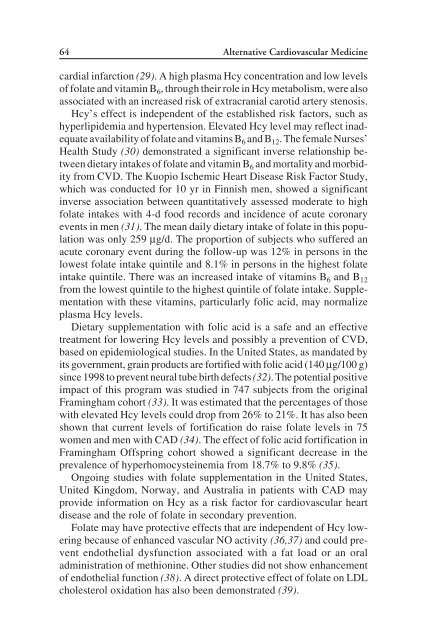Complementary Alternative Cardiovascular Medicine
Complementary Alternative Cardiovascular Medicine
Complementary Alternative Cardiovascular Medicine
You also want an ePaper? Increase the reach of your titles
YUMPU automatically turns print PDFs into web optimized ePapers that Google loves.
64 <strong>Alternative</strong> <strong>Cardiovascular</strong> <strong>Medicine</strong><br />
cardial infarction (29). A high plasma Hcy concentration and low levels<br />
of folate and vitamin B 6, through their role in Hcy metabolism, were also<br />
associated with an increased risk of extracranial carotid artery stenosis.<br />
Hcy’s effect is independent of the established risk factors, such as<br />
hyperlipidemia and hypertension. Elevated Hcy level may reflect inadequate<br />
availability of folate and vitamins B 6 and B 12. The female Nurses’<br />
Health Study (30) demonstrated a significant inverse relationship between<br />
dietary intakes of folate and vitamin B 6 and mortality and morbidity<br />
from CVD. The Kuopio Ischemic Heart Disease Risk Factor Study,<br />
which was conducted for 10 yr in Finnish men, showed a significant<br />
inverse association between quantitatively assessed moderate to high<br />
folate intakes with 4-d food records and incidence of acute coronary<br />
events in men (31). The mean daily dietary intake of folate in this population<br />
was only 259 µg/d. The proportion of subjects who suffered an<br />
acute coronary event during the follow-up was 12% in persons in the<br />
lowest folate intake quintile and 8.1% in persons in the highest folate<br />
intake quintile. There was an increased intake of vitamins B 6 and B 12<br />
from the lowest quintile to the highest quintile of folate intake. Supplementation<br />
with these vitamins, particularly folic acid, may normalize<br />
plasma Hcy levels.<br />
Dietary supplementation with folic acid is a safe and an effective<br />
treatment for lowering Hcy levels and possibly a prevention of CVD,<br />
based on epidemiological studies. In the United States, as mandated by<br />
its government, grain products are fortified with folic acid (140 µg/100 g)<br />
since 1998 to prevent neural tube birth defects (32). The potential positive<br />
impact of this program was studied in 747 subjects from the original<br />
Framingham cohort (33). It was estimated that the percentages of those<br />
with elevated Hcy levels could drop from 26% to 21%. It has also been<br />
shown that current levels of fortification do raise folate levels in 75<br />
women and men with CAD (34). The effect of folic acid fortification in<br />
Framingham Offspring cohort showed a significant decrease in the<br />
prevalence of hyperhomocysteinemia from 18.7% to 9.8% (35).<br />
Ongoing studies with folate supplementation in the United States,<br />
United Kingdom, Norway, and Australia in patients with CAD may<br />
provide information on Hcy as a risk factor for cardiovascular heart<br />
disease and the role of folate in secondary prevention.<br />
Folate may have protective effects that are independent of Hcy lowering<br />
because of enhanced vascular NO activity (36,37) and could prevent<br />
endothelial dysfunction associated with a fat load or an oral<br />
administration of methionine. Other studies did not show enhancement<br />
of endothelial function (38). A direct protective effect of folate on LDL<br />
cholesterol oxidation has also been demonstrated (39).


